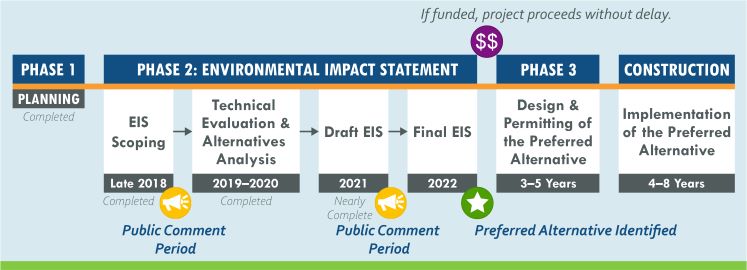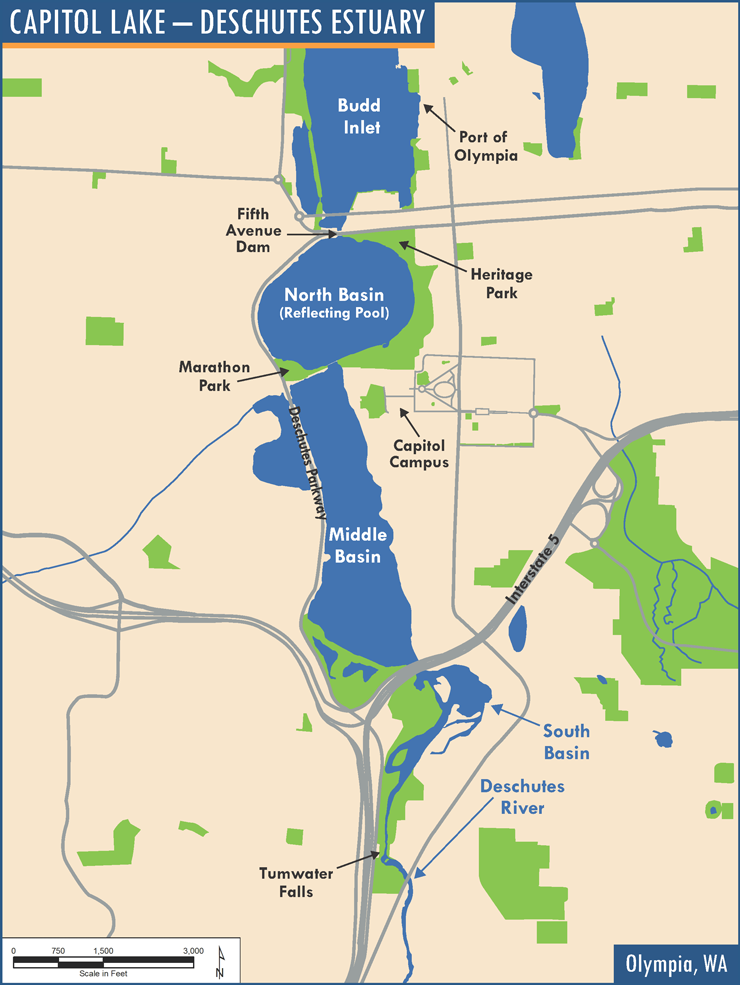
For up-to-date information on the restoration project,
visit the project site:


Did you hear the
big news?
DES selected a preliminary preferred alternative and have identified the Estuary Alternative as the likely preferred alternative!!
This is of course very big news for DERT and our community.
DERT’s Comments on the DEIS
– Summer 2021 –
DERT’s final comments on the Draft Environmental Impact Statement (EIS) are posted below. While we agree with the Draft EIS that the estuary alternative will significantly improve habitat and water quality conditions, is the most cost effective alternative, and would greatly reduce or eradicate the invasive species that have plagued the lower Deschutes River basin for decades, we have numerous concerns with the Draft EIS document and the evaluate process and criteria that produced it. Our comments and concerns are detailed in the PDF document posted below.
We would like to emphasize that the Executive Summary of the Draft EIS is misleading – Indeed, there is a frequent disconnect between statements made in the Executive Summary and the actual content of the substantive chapters in the DEIS. These are errors of both omission and emphasis. We will point out some examples below. Sadly, most people will have only enough time and energy to review the Executive Summary. Therefore, we are demanding that the Executive Summary in the final EIS be more accurate and unbiased in its statements.
Project Background
In 2016, stakeholders, in collaboration with Washington State Department of Enterprise Services (Enterprise Services), identified common goals that should be satisfied by any long-term management alternative. In 2018, Enterprise Services was directed by the State Legislature to develop an Environmental Impact Statement (EIS) that evaluates alternatives for long-term management. Enterprise Services has published a Draft EIS that documents potential environmental impacts of various alternatives and determine how these alternatives meet the long-term management objectives.
The EIS will evaluate and identify a preferred environmentally and economically sustainable long-term management alternative for the Capitol Lake – Deschutes Estuary Project.

What to Expect
The Draft EIS provides a description of the long-term management alternatives and a discussion of significant environmental impacts and benefits, as well as mitigation measures that would avoid or minimize adverse impacts or enhance environmental quality. Neither short-term actions (e.g., dredging) nor construction of a long-term management alternative (Estuary, Hybrid, or Managed Lake) can be implemented without an EIS. The release of the Draft EIS marks a key milestone in the process to identify, and then implement, a long-term management alternative that will best achieve project goals.
The State Legislature has required that DES evaluate a Managed Lake, Estuary, and Hybrid Alternative in the EIS. In an EIS, an analysis of the “No Action Alternative” is also required.
The Draft EIS includes Project Background and History, in addition to:
- Project Alternatives and Construction Approach
- Existing Conditions and Affected Environment
- Long-Term Impacts, Benefits, and Mitigation
- Short-Term Impacts and Mitigation
- Cumulative Effects
- Planning-Level Costs
- Funding and Governance, Work Groups, and Community Sounding Board
- Permits and Approvals for Implementation of a Preferred Alternative

Capitol Lake – Deschutes Estuary
The Deschutes Estuary includes the 260-acre Capitol Lake Basin, located on the Washington State Capitol Campus, in Olympia, Washington. This water body is an important recreational resource and valued amenity; however, it suffers from numerous environmental issues.

Water Quality Standard Violations
Capitol Lake is currently violating water quality standards because of high levels of phosphorus, which cause algae blooms that deplete dissolved oxygen in Capitol Lake and the adjacent Budd Inlet, using up oxygen essential for fish and other aquatic life.

Sediment Management Issues
Every year more than 35,000 cubic yards of sediment from the Deschutes River is deposited within the lake basins, resulting in increasingly shallow conditions. Today, the lake is about 21 percent smaller and it holds roughly 60 percent less water than it did in 1951.

Presence of Invasive Species
Fish and wildlife habitat are impacted due to the presence of several invasive and nuisance species including the New Zealand mudsnail, purple loosestrife, Eurasian watermilfoil, nutria, and Canada geese. These species out compete and negatively impact native populations.

Restricted Active Community Use
Over the years, high bacterial levels and the presence of invasive species have resulted in impacts to the recreational use of Capitol Lake. The presence of New Zealand mudsnails resulted in official closure to all active uses in 2009 and active use of the waterbody continues to be restricted today.
The Environmental Impact Statement’s Community Sounding Board
The CSB is a group of individuals selected to represent an array of interests, organizations, and communities who will meet quarterly to round-table discuss their beliefs and opinions around the process and outcome of the Environmental Impact Statement process. This includes representatives from, DERT, Evergreen State College, the Olympia Yacht Club, Evergreen, Chamber of Commerce, Capitol Lake Improvement and Protection Association (CLIPA), Sierra Club, and citizens with varied interests.
Deschutes Estuary Restoration Team’s EIS Scoping Recommendations
“Scoping” is the process of seeking community input on the scope of the Environmental Impact Statement. DERT and our followers submitted comments urging the study to include vital elements relating to technical analysis, economics, cultural resources, historic preservation, climate change, and more. The initial comment period has closed, but we are leaving our recommendations up for reference. You can read the results of the initial scoping process here: Scoping Report 2/19.
Relating to Technical Analysis
The EIS should:
- Include a study of projected climate impacts localized to the study area; including sea level rise and the likely frequent inundation of downtown Olympia particularly in high river flow events and “king tides”.
- Include a thorough technical analysis of sediment transport.
- Include a number of scenarios for sediment management along the lower stretch of the river (from Tumwater falls to Budd Inlet).
- Include a study on flooding. DERT believes a restored estuary would hold more capacity for flood waters than the current dammed sediment reservoir. This idea needs to be modeled using available data and current sea level rise predictions taking into consideration water coming in and water coming up through filled areas.
- Examine the ability of each outcome presented to sustain itself; with minimal long-term maintenance and associated cost. Outcomes compared should be compared in terms of resiliency to climate change. See “Our history comes at a perpetual cost” an editorial in the Olympian dated 9/7/18 [1]
- Analyze the potential for and amount of salmon habitat created for juvenile salmon and returning adults; (reference Squaxin’s salmon tracking, and in the context of Inslee’s Orca Task Force)
- Consider the sources of Budd Inlet’s current violation of federal water quality standards, and which alternatives will improve and maintain water quality.
- Address the best way to return native plants and wildlife to an estuary, as well as which natural conditions discourage invasive species.
- Determine potential impacts to bat populations (migrations between Woodard Bay and Capitol Lake) and develop mitigation scenarios for those impacts
- Include blue carbon science in mitigation projects to sequester carbon and offset methane release from existing sediment reservoir/lake. [2]
- The EIS should consider the preservation of the integrity of the lower Deschutes Watershed and Budd Inlet ecosystems including the use and quality of these areas for future generations.
Relating to Economics
The EIS should address:
- Tourism attractions for Washington State and beyond including access to the shoreline for kayaking, bird watching.
- Supportive forms of recreation and aesthetics from study area to Boston Harbor (Doffelmeyer Point)
- Re-opening of recreational access in the lower river area – now called Capitol Lake.
- Job creation during construction.
Relating to Historic and Cultural Preservation
The EIS should address:
- The analysis of existing conditions should trace the environmental history from estuary to its current configuration, making use of geotechnical, archaeological, and historical data in conjunction with tribal knowledge because of its current altered state.
- Native treaty rights in Washington State:
- The EIS must consider the impacts that the dam and settlement basin have on rights reserved by tribes in Article III of the Treaty of Medicine Creek. The “Boldt Part 2” decision mandates that the State not allow fish and other species to decline or become extinct, and therefore options considered by the EIS must address outcomes through the lens of treaty-guaranteed fishing and gathering rights past, present, and future.
- Cultural resource studies:
- Cultural resource discussion needs to address the ways in which tribes managed natural resources for cultural purposes. This is especially important because the project area includes and surrounds ancient settlements.
- Cultural resource investigations informing the EIS will need to improve on archaeological data; we know that some sites exist, but do not have a good handle on their exact locations or ages. The known and likely resources range from ancient habitation and resource use areas to early historic sites of Olympia.
Contributors
Dave Monthie
Mo Major
Dave Peeler
Ali Johnson
Ann Butler
Karen Janowitz
Sue Patnude


